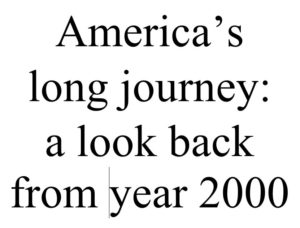
Nineteenth century (1900 back to 1800)
Electricity
As long ago as 1800, Alessandro Volta developed the voltaic pile, the first battery, which produced electricity from chemical reactions. In 1831, Michael Faraday figured out how to generate electricity from rotary motion. But it wasn’t until 1878 that Thomas Edison developed and sold a system to generate and distribute electricity. In 1879 he invented a practical incandescent light bulb, a carbon filament sealed in a vacuum, and began commercial production of carbon filament bulbs the following year. (He wasn’t the only inventor of the light bulb, but his was the one that succeeded commercially.) Then, in 1882, he opened power stations in London and New York City, providing commercially viable alternatives to gas lighting and heating. Edison’s Pearl Street Station in New York began with 85 customers using 400 lamps. By 1884 Pearl Street was supplying 508 customers with 10,164 lamps. Success. But each of Edison’s power stations could only serve a one-mile radius, due to restrictions posed by the use of a direct-current (DC) system. Thus his system would be practical only for city centers and special uses.
A brief painless explanation: Any electrical system has to choose how much voltage to send through the wires. The greater the voltage, the smaller the current, and therefore the thinner the transmission wire can be (smaller current generates less resistance). On the other hand, greater voltage comes with three disadvantages: It requires thicker insulation, and it won’t work with certain loads. (Also, it is more likely to give you a dangerous shock if you come into contact with it.)
The answer was alternating current, or AC, developed by Nikola Tesla and others and made practical commercially by industrialists such as George Westinghouse. AC transformers allowed the power station to send power at higher voltages. This reduced the current, and therefore reduced the size of the wire, and reduced distribution losses from resistance. At the other end of the line, transformers at local substations reduced the voltage to supply loads. Only AC made it possible to locate generators in one place, such as a dam, and distribute power over long distances.
AC was introduced only a few years after Edison’s initial power plants went into operation. He fought it tooth and nail as long as he could, but the advantages of the AC system were overwhelming. The War of Currents, as it was called, resulted in a complete victory for AC. DC systems were relegated to special uses. In a short while, electric wires were being stretched in all directions, a process that would continue in America at uneven rates for a period of about 70 years. One New Deal program often cited for its transformative effects is the Rural Electrification Agency, which brought electric power to places previously unreached.
A computer search beginning with the word electricity or electric-power generation or some similar term will lead you down fascinating byways, either technical or historical or both. The development of steam turbines, for instance, made generation of AC power much cheaper and more reliable. The development of the electric-power grid, which became the near-universal means of transmission, and upon which the country still relies, is another important story. Once you get the idea of the 19th century as being the century in which humanity burst through age-old constraints, you begin to see it as they did, as a century of marvels.
Electricity was but one more of the 19th century’s revolutionary developments. Initially it was steam, the first new source of energy harnessed since medieval man developed windmills. Steam engines powered boats that could travel without regard to the wind, and could steam up-river. Steam railroads traveled at speeds four or five times faster than a galloping horse, and unlike the horse they could keep it up day and night, as long as the fuel held out and the boiler didn’t burst. The electric telegraph provided virtually instant communication, day and night, wherever the wires extended. And now here was electricity, the equivalent of a power plant in every home and factory. Instead of candles and oil lamps, electric lights. Instead of belt-driven systems powered by steam engines, fractional-horsepower electric motors.
Like all new technology, electricity started out relatively expensive, relatively restricted in use. New users and technological improvements brought down costs and expanded applications, until within a relatively short time people became accustomed to doing things they hadn’t dreamed of being able to do only a few years before. We’ve seen it in our time with personal computers. Electricity in the home and shop was no less revolutionary to the Victorians.